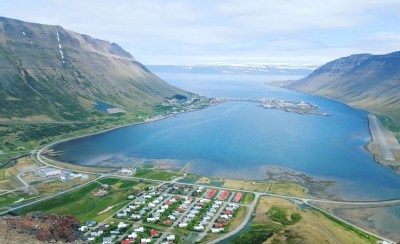Search for cities, countries, lakes and rivers
Iceland

Iceland © By Olga Ernst
Iceland Sea Temperature
This page provides detailed information about the water temperature in Iceland. All countries, cities and resorts on the coast. The range of sea temperatures for today. We find every spot where you can swim and tell you what the water temperature is there today and throughout the year.
Current Sea Temperature
5.2°C
minimal
7.7°C
average
8.6°C
maximum
Graph of Sea Temperature Changes in Iceland Over the Last 60 Days
The Warmest Places on the Seaside in Iceland Today
The Most Popular Seaside Resorts in Iceland
Seas and Oceans that Border Iceland

Iceland, © By Berit



Water Temperature in Iceland: General Trends and Swimming Opportunities
Iceland, located in the North Atlantic, is known for its dramatic landscapes of volcanoes, glaciers, and geothermal hot springs, but its sea temperatures are cold, especially for those unaccustomed to such conditions. The average sea temperature around Iceland ranges from 3°C (37°F) in the winter to about 10°C (50°F) in the summer. While these temperatures make outdoor swimming in the open ocean challenging, they are ideal for those seeking a more adventurous swimming experience with proper gear, such as wetsuits.
Despite the chilly waters, Iceland offers a number of natural hot springs and geothermal pools where visitors can enjoy a warm, relaxing swim. The Blue Lagoon, located near Reykjavik, is the most famous of these, but there are numerous other geothermal spots scattered across the country. These hot springs are an excellent alternative to cold ocean swimming, providing an unforgettable bathing experience surrounded by stunning volcanic landscapes. In addition to these pools, there are also several natural hot river baths, like those in Reykjadalur, which provide a unique way to enjoy the warmth of Iceland’s geothermal activity.
While Iceland may not be a traditional swimming destination due to its cold waters, it offers a unique combination of cold-water experiences, hot springs, and a variety of outdoor activities such as kayaking, whale watching, and diving. The country's coastal waters, particularly near glaciers and icebergs, provide a rare opportunity for those seeking a more rugged, adventurous encounter with the sea.
General Information and Geographical Location of Iceland
Original name of the country: Ísland
Iceland is located in Europe. The country is washed by the Atlantic Ocean and the Norwegian Sea. Iceland - has a fairly long coastline. To determine the temperature of the water in it, we monitor 17 settlements and resorts. Link to Google Maps.
Iceland Weather
Iceland has a subarctic and oceanic climate, influenced by the North Atlantic Ocean and the Gulf Stream. Summers, from June to August, are cool and mild, with average temperatures ranging from 50°F to 60°F (10°C to 16°C). The coastal areas, including Reykjavik, experience slightly warmer temperatures, while the highlands remain much cooler. Rainfall is frequent throughout the year, and summer often brings cloudy skies and occasional strong winds. Despite the cool weather, Iceland enjoys long daylight hours in summer, with the Midnight Sun providing almost 24 hours of light in June.
Winters, from December to February, are cold but not as extreme as in some other northern regions, with temperatures generally between 20°F and 35°F (-7°C to 2°C). The coastal areas stay milder due to the ocean’s influence, while inland and northern parts can experience lower temperatures. Snowfall is common, especially in the mountains, but rain and strong winds are also frequent in winter. The limited daylight during the winter months, with as little as four to five hours of sunlight in December, creates a dramatic and unique atmosphere. Despite the cold, Iceland’s climate is relatively moderate compared to its latitude, thanks to the warming effects of the surrounding ocean currents.
Frequently Asked Questions About Iceland and its Water Temperatures
What is the sea temperature today on the coast of Iceland?
The sea temperature today on the coast of Iceland ranges from from 41°F (5.2°C) in Dalvik to 47°F (8.6°C) in Vestmannaeyjar.
Which seas and oceans border Iceland?
Iceland has access to two seas: the Atlantic Ocean and the Norwegian Sea.
How long is the coastline in Iceland?
According to The World Factbook, the length of Iceland's coastline is 3,088 miles (4,970 km), while the World Resources Institute estimates it at 5,285 miles (8,506 km).
What is the best time for swimming and beach holidays on the coast of Iceland?
In Iceland, the average monthly sea temperature does not rise above 68 degrees Fahrenheit (20 degrees Celsius) in any month of the year. The highest water temperature occurs in August and reaches only 59 degrees Fahrenheit (15 degrees Celsius).
What is the sea temperature history in Iceland?
Here are the ranges of sea temperatures in Iceland by month based on historical data: in January from 32°F (0°C) to 46°F (8°C), in February from 32°F (0°C) to 46°F (8°C), in March from 32°F (0°C) to 46°F (8°C), in April from 32°F (0°C) to 48°F (9°C), in May from 32°F (0°C) to 48°F (9°C), in June from 39°F (4°C) to 53°F (12°C), in July from 42°F (6°C) to 57°F (14°C), in August from 44°F (7°C) to 59°F (15°C), in September from 39°F (4°C) to 57°F (14°C), in October from 35°F (2°C) to 51°F (11°C), in November from 33°F (1°C) to 50°F (10°C), in December from 28°F (-2°C) to 46°F (8°C).
